Why did Antonio de Nebrija draw faces into a Dutch book from 1480?
The humanist Antonio de Nebrija (c. 1444-d.1522) was a serious scholar, renowned for his work on the Spanish language. His hidden talent for drawing expressive faces, however, is less well known.
Gutenberg’s invention of printing text with movable metal type in 1455 led to the production of editions with identical copies (unless corrections were made during the printing process). Depending on the kind of text, the execution, and the decade – numbers go up towards the end of the century –, fifteenth-century printers produced somewhere between 100 to 1000 copies of a single edition. Most copies have been lost over the past five centuries, but a sizeable amount (c. half a million) is still kept in collections of (research) libraries, museums and private collectors. These books bear the marks and traces of their owners, of the ways in which they were used and decorated – a fifteenth-century book did not come off the press as a fully finished product, but usually required the insertion of initials and decoration. Binding was also often added at the discretion of the buyer.
The Importance of Individual Copies
A study of individual copies can tell us more about their dissemination, their readership and ways and contexts in which they were used. In my research project on the Dutch printer Gerard Leeu, I study a significant number of copies of his various editions of religious works in the Dutch vernacular. Leeu was, for example, the first printer in the Low Countries to publish the Legenda aurea, a highly popular, voluminous collection of saints’ lives compiled by the Genovese archbishop Jacobus de Voragine in the thirteenth century. Leeu printed the first edition of a Dutch translation – the Passionael, named after the suffering, i.e., the passion, of the saints – in the Dutch town of Gouda in 1478. This was followed up by a second edition that appeared approximately two years later, in February and April 1480. Some twenty-three copies are still extant of the latter edition, kept in libraries in the Netherlands, France, Belgium, Sweden, UK, and the United States of America.
Hand-written corrections and reading instructions in these copies can tell us more about reading practices. The copy kept in Leeu’s hometown Gouda, for example, directs readers to stop reading, skip certain sections and leaf through to continue. Some owners left their name in their book. These inscriptions generally point to female readers (compare Hellinga 1993, p. 28). A copy, currently kept at the John Rylands Library in Manchester, was in the possession of the Haarlem inhabitant Lijsbet vanden Venne, who noted in the back of the book that if anyone failed to return it to her then ‘the devil will grab you by the foot’ [zoe gript die duvel biden voet].
Apparently Lijsbet donated her book to the convent of Tertiaries of Saint Mary Magdalene in Haarlem – a convent inhabited by former prostitutes – who made their ownership of the book known through an inscription beneath Lijsbet’s: ‘This book belongs to the Magdelenes in Haarlem’ [Dit boec hoert toe die magdalenen binnen haerlem]. An additional argument for the Haarlem provenance of this copy are the initials inserted throughout the book, decorated with pen flourishes or ‘pen work’ in a local style typical of the area. A copy kept at the Bibliothèque nationale in Paris displays the same Haarlem style; one could surmise it too was used there.
A Copy of the Passionael owned by Nebrija
Some copies, however, wandered far from home. An analysis of a copy kept at the Tilburg University Library yielded a surprising result. Beneath the prologue, on the back of the book’s second leaf, we find a name written with black ink in a cursive, fifteenth-century letter. Although the first name is slightly smudged, the note unmistakably reads ‘Antonius Nebrissensis’, which is the Latinized name of the famous Elio Antonio de Nebrija [Fig. 1].
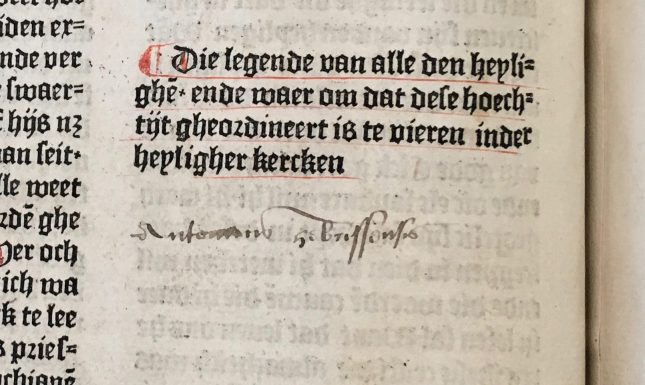
Nebrija [Fig. 2] published extensively during his lifetime: in 1481 his teaching text Introductiones latinae appeared at Salamanca. Other works were to follow suit, not only on Latin, but on the Castilian vernacular as well. In 1492 – incidentally the year of Leeu’s demise – his Castillian grammar was printed, the first grammar of a vernacular language to be published in Europe. The year 1495 ushered in the publication of his Latin – Spanish dictionary. Besides studying the Latin and Spanish languages, Nebrija also engaged in Biblical philological criticism.
So why did a Spanish humanist own a book about saints’ lives published in Dutch by Gerard Leeu? Was it his interest in Biblical scholarship that sparked interest in the collection of saints’ lives? Or was it his interest in grammar and lexicography of vernacular languages that made him acquire the book? These queries lead to yet more questions: how and when did Nebrija acquire the book? Was it through a network of humanists?

Leeu was acquainted with the young Erasmus and one of his editors was the humanist Jacobus Canter, who prepared Leeu’s editions of Petrarca’sDe secreto and Proba Faltonia’s Cento, a poem of Jesus’ life composed of Virgil’s verses. Another way Nebrija might have acquired the Dutch Passionael was as a gift, possibly through his royal connections. His Gramáticca castellana (1492) was dedicated to Queen Isabella I of Castile and in 1509 Nebrija was appointed royal historian by King Ferdinand to chronicle their reign. In the meantime, their daughter Joanna had married Philip the Handsome (1496), which started a centuries-long association between Spain and the Low Countries. Did this bond inspire an interest in the edition and language?
Nebrija's Faces
Whatever the case, Nebrija seems to have actively read – or at least leafed through – the book. His reading – or browsing – did not leave any insightful and intellectual notes. Rather, Nebrija appears to have drawn faces into a number of the red and blue initials that were already added in Holland. A red ‘O’ contains a face of someone yawning (?) [Fig. 3], a blue ‘D’ the face of a somewhat surprised looking bearded man [Fig. 4].

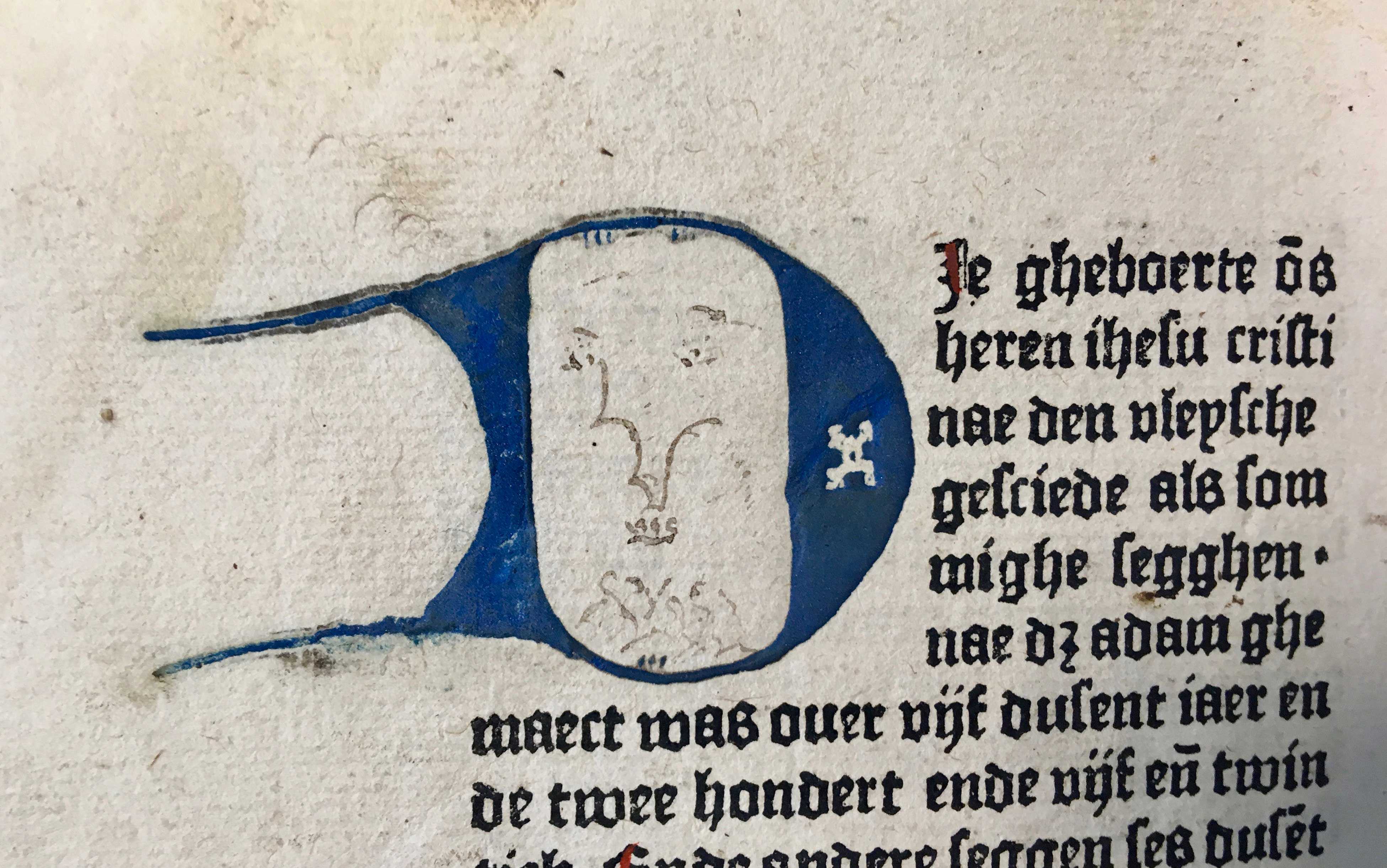
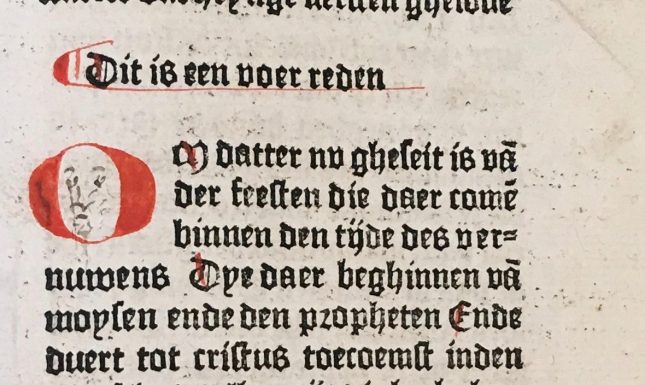

Although it is difficult to establish Nebrija’s hand in these doodles with absolute certainty, the ink seems to be the same. Did Nebrija use the same pen with which he wrote his name to draw the faces into his copy of the Passionael? Did he take to doodling in his copy out of boredom with the Dutch text? We can only speculate.
The copies of Leeu’s 1480 Passionael incidentally attracted more ‘aspiring artists’, possibly due to the book’s ample margins and blank spaces. All of these markings are of a later date than Nebrija’s, however. In the copy kept at Leiden University Library, someone – perhaps a sixteenth- or seventeenth-century reader – drew figures in brown ink in the upper and lower margins of the book. Most of them have been ‘beheaded’ when the book block was trimmed for a new binding. A sketch of a knight ready to attack his opponent was left unfinished [Fig. 5].
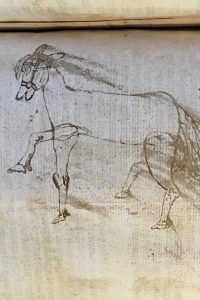

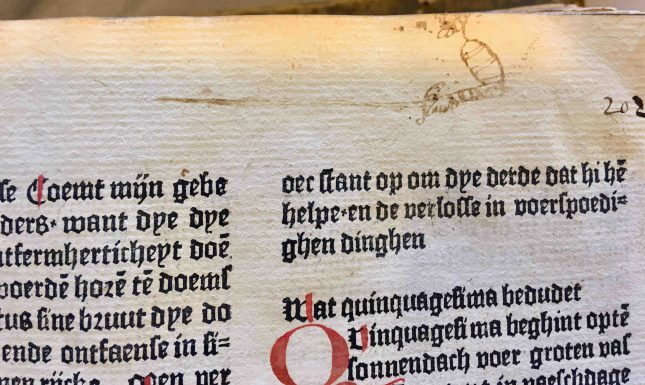
Meanwhile, it appears that another ‘artist’ drew a horse on the back of the last leaf of the copy [Fig. 6]. Possibly – hopefully – a child (eighteenth century?) drew a squire in the same place in a copy currently kept at the Royal Library in The Hague [Fig. 7].
Nebrija’s doodles, however, are not only unique because they are contemporary to the copy. Their uniqueness lies especially in the fact they flowed out of the pen of one of Spain’s greatest humanists. Nebrija’s ownership of the book tells us that books in the Dutch vernacular published by Leeu reached intellectuals far beyond the Low Countries.
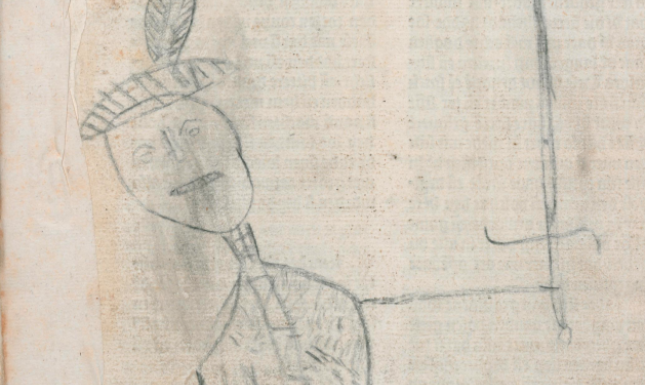

Bibliography
Hellinga, Lotte, ‘De betekenis van Gheraert Leeu’, in K. Goudriaan et al., Een drukker zoekt publiek. Gheraert Leeu te Gouda, 1477-1484. Delft: Eburon, 1993.
McRae, Laura, ‘Nebrija, Antonio de (1444?–1522)’, in Clayton J. Drees ed., The Late Medieval Age of Crisis and Renewal, 1300-1500 : A Biographical Dictionary. Westport Conn.: Greenwood Press, 2001, 364-365.
© Anna Dlabačová and Leiden Medievalists Blog, 2020. Unauthorised use and/or duplication of this material without express and written permission from this site’s author and/or owner is strictly prohibited. Excerpts and links may be used, provided that full and clear credit is given to Anna Dlabačová and Leiden Medievalists Blog with appropriate and specific direction to the original content.


